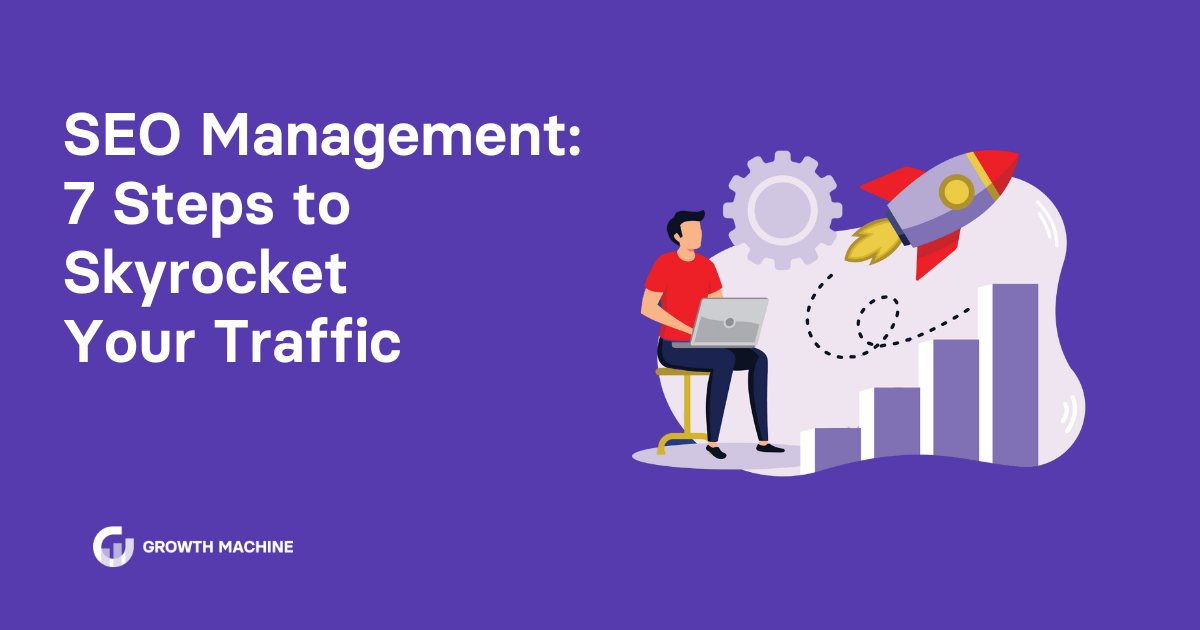SEO Management: 7 Steps to Skyrocket Your Traffic
As a small business owner, you’ve no doubt heard how important it is to try your hand at SEO, or search engine optimization. This digital marketing practice can get a little complex, but it’s crucial for you to understand how SEO works and leverage it for your business.
To put things into perspective, there are more than 80 billion Google searches conducted every single month — that’s a lot of potential online visibility for your business. You need a stellar SEO strategy to get those eyes on your content and attract more website traffic.
In this guide, we’ll break down the complex maze of SEO management, teach you the value of strategic SEO, and share the most up-to-date content marketing techniques to put you on the front page of Google.
What Is SEO and How Does It Work?
Search engine optimization (SEO) is the process of optimizing your website content so search engines like Google or Bing will associate your content with specific search terms or keywords. The goal of SEO is ultimately to increase visibility in organic (non-paid) search engine results, drawing more organic traffic and ensuring a more seamless user experience.
This is the opposite of paid search, where businesses pay out the wazoo for pay-per-click (PPC) ads to generate traffic. Paid ads are a fast fix for boosting landing page traffic, but they can quickly drain your budget. Plus, they have little to no benefit on your rankings on the search engine results page (SERP) long-term.
Organic SEO is, hands down, the best marketing strategy for growing businesses. You may not see results overnight, but boosting your SEO ranking will help you:
- Deliver more value to site visitors
- Improve your credibility
- Gain a competitive advantage over other sites on the SERPs
- Increase conversions and sales
That sounds great in theory. But how does SEO actually work? And what steps do you need to take when creating SEO content for your website?
Understanding how search engines work will help you master the ins and outs of SEO management.
Essentially, search engines use a series of calculations or predictions called algorithms to rank websites. These algorithms consider factors like content quality, backlinks, site loading speed, and more.
Search engines aren’t always upfront about their ranking factors, but by accounting for these common factors in your content creation process, you’re telling search engines that your site deserves those top rankings for specific keywords.
The 5 Key Components of SEO
SEO is changing all the time. It has so many nuances, so it can feel tough to know where to begin if you’re new to it. Every good SEO strategy has five major components.
1. User-Focused Content
Content management is the heart of SEO. After all, search engine users are looking for information to solve their biggest pain points. If your content is lacking, it’s unlikely that users or search engines will rank your site well in the SERPs.
When it comes to creating high-quality content that users will click on, you need to consider:
- Depth: Your content should be long and detailed enough to add value to readers.
- Originality: This requires you to add something new to the conversation, rather than simply recycling your competitors’ ideas. If you’re strapped for time, hire SEO services like Growth Machine to generate head-turning content that helps you rank in search.
- Relevancy: Your blog posts should address popular search queries in your industry and closely match user intent.
- Frequency: Businesses that dominate the search rankings regularly publish new content and refresh older pieces of content.
- Multimedia: Effective content includes images, videos, and infographics to enhance reader understanding and encourage social media shares.
2. On-Page SEO
On-page SEO is a specialized type of SEO where you tweak components on every landing page to keep visitors on-site.
On-page SEO includes the following:
- Keyword use: Use relevant keywords in titles, headers, meta descriptions, and the content you create.
- Internal linking: Both users and search engines should be able to use links and relevant anchor text to discover other relevant content on your site.
- Image optimization: This includes image size and compression where needed. You should also add alt text to help search engines decipher what the image is all about (this is also crucial for accessibility).
3. Off-Page SEO
Off-page SEO optimizes the external factors that influence your web page’s search ranking. Most off-page SEO focuses on backlinks, or the quality and quantity of links to your site from reputable sources.
Off-page SEO can also include:
- Social media shares
- Brand mentions
- Earned media
- Podcast interviews
Search engines consider off-page SEO factors to determine how reputable your site is. If other trustworthy websites link to you, search engines infer that your website is also trustworthy.
It takes a little elbow grease to earn high-quality backlinks, but it’s worth the effort. To brush up on your backlink outreach strategy, check out our guide on how to secure quality backlinks.
4. Technical SEO
Technical SEO can get a little complicated. The goal of technical SEO is to ensure that search engine crawlers can index your website without any issues. It encompasses elements like:
- Website load speed and performance
- Proper meta tags in page content
- Regular SEO audits to spot performance issues
- Mobile friendliness and responsiveness
- XML sitemaps (a file that lists your website’s essential pages to ensure Google can find and crawl them)
- Structured data (the way data or content is grouped or structured on a certain page) like schema markup
- Security of your website (adding “HTTPS” to your URL with an SSL certificate)
You may need to hire a web developer to handle some elements of technical SEO, especially if you don’t know how to code in HTML.
5. Local SEO
Last but certainly not least, local SEO is designed for businesses that have a physical presence. This component of SEO drives traffic to a brick-and-mortar store, which is perfect if you offer services in a specific geographic area instead of selling e-commerce products to buyers worldwide.
Local SEO is critical if you want your business to appear in local search results and Google Maps listings. Key ranking factors include:
- Claiming and optimizing your Google Business Profile with key information such as your business name, address, and phone number (NAP).
- Gathering and responding to customer reviews.
- Building links from local sources, such as local websites, newspapers, influencers, and other organizations.
What Is SEO Management?
Understanding the five components of SEO will get you far, but you still need a strategy for managing all the moving parts of your SEO strategy.
SEO management is a systematic approach to optimizing a business’s website and online content, with the goal of improving its search engine rankings.
SEO encompasses a lot of disciplines, so you need a multifaceted team to stay on top of your search engine marketing strategies. For example, just because someone is a great content writer doesn’t mean they have a deep understanding of technical SEO. Either way, the wider the range of knowledge and expertise you can bring to the table, the more likely you are to succeed.
Just like Rome wasn’t built in a day, effective SEO doesn’t happen overnight — or even in a few weeks. It requires a strategic, step-by-step plan that addresses all five components of SEO. Ensuring that all parts of your SEO are working in harmony will give you the best shot at boosting those organic search rankings and bringing more traffic to your website.
7 Ways to Level Up Your SEO Management
Whether you’re ready to tackle it with your internal marketing team or you’re looking to outsource to an experienced SEO agency, here’s how to improve your website’s search rankings.
1. Start With Your Business Goals
Effective SEO management is inextricably linked to your business goals. Your SEO strategy should connect to certain business objectives, such as:
- Increasing product sales through keyword research that identifies product-specific keywords, then including those keywords in product pages.
- Establishing a brand presence in a new market or segment by targeting industry-specific keywords or producing blog posts that address common questions or challenges in that market.
- Acquiring new local leads by optimizing service pages, creating value-driven content that demonstrates expertise in your industry, and incorporating local SEO tactics.
- Reducing customer acquisition costs by investing in long-term SEO strategies that bring steady traffic without spending thousands a month on paid ads. This can also include producing evergreen content, building a robust backlink profile, and ensuring that technical SEO is on point.
By starting out with your end goal in mind, you’ll be able to ensure that your efforts translate into tangible outcomes for your business.
2. Conduct Keyword Research
Before you even start writing content, you need to identify the words and phrases your target audience uses when searching online. This approach increases the odds that your target audience will actually find and interact with your content.
We recommend using a tool like Google Keyword Planner, Semrush, or Ahrefs to start your keyword search. These tools can help you better understand your audience intent, analyze keyword competitiveness, and identify keyword opportunities.
But don’t go after high-competition keywords right now. At Growth Machine, we focus on targeting long-tail keywords in our SEO strategies. Long-tail keywords often have less competition and a clear search intent. While traffic tends to be lower for these keywords, they’re the holy grail for generating faster SEO wins.
3. Optimize Your Website Structure & User Experience
There’s nothing a search engine loves more than a well-structured website with an intuitive user experience.
You don’t need to hire a fancy website designer for this, either. The best thing you can do for the user experience is to create a mobile-friendly website. After all, more than 50% of web traffic comes from mobile. Google even has a free Mobile-Friendly Test to help you assess and improve your site’s mobile performance.
Site structure is a little more complicated, but it can lead to serious gains in SEO rankings. Draw on elements of technical SEO to optimize your site for search engine crawlers. That means optimizing:
- Site speed and performance
- Checking that your site is optimized for mobile
- Setting up XML sitemaps and robots.txt
- Checking and fixing crawl errors
- Implementing structured data markups
If that sounds complicated, don’t sweat it. Hire a technical SEO expert to work on the back end of your site — their pricing is worth the gains you’ll see in SEO performance.
4. Create High-Quality Content Optimized for SEO
The best way to increase your search ranking is to deliver high-quality, relevant content that addresses popular search queries.
There are several ways that you can optimize your content creation for SEO:
- Write new content regularly: Remember, your content should be original and thorough.
- Check out the competition: Feeling uninspired with your content ideas? Take a quick peek at what other websites or blogs in your industry are writing about. But don’t copy them — see where you can add a unique point of view or additional insights based on your expertise.
- Updating your existing content: Bring old content back to life with a few small tweaks. Revisit your older blog posts periodically to see if the content is still accurate, or if it requires a bit of a facelift to keep up with current trends and happenings. Sometimes adding a frequently asked questions (FAQ) section is all it takes to boost search performance.
- Repurpose evergreen content: Repurpose and recycle existing content into other forms. Have an evergreen blog post that hasn’t seen new traffic in awhile? Recycle it into a social media graphic or a helpful infographic to breathe new life into it and watch your organic traffic grow!
At Growth Machine, creating optimized content for SEO is our bread and butter. See how we added 120,000+ monthly organic sessions for a sleep app through long-form blog content.
5. Improve Off-Page SEO With Backlink Outreach
Quality backlinks from reputable websites in your industry are one of the best ways to boost your site’s credibility, both in the eyes of search engines and your target audience.
When it comes to link building, a good rule of thumb is to aim for quality over quantity. One good link from an authoritative site beats dozens of low-quality links any day. Skip the submissions to spammy business directories and focus on guest blogging, influencer outreach, or cold emailing.
Pro tip: A tool like Moz or Ahrefs can help you monitor your existing backlink performance, identify opportunities for new backlinks, and evaluate which backlink sources your competitors are using.
Don’t forget to monitor your backlinks and remove broken or poor-quality links to keep your link profile in tip-top shape.
6. Monitor Your Performance
It’s difficult to know where to go if you don’t know where you’ve been. Continuously assessing your website’s SEO performance will help you spot opportunities for improvement and make adjustments where necessary.
Tools like Google Analytics and Google Search Console can help you track key metrics and KPIs like organic traffic, bounce rates, and conversions.
Pay close attention to where traffic is coming from and where you’re losing people. This could indicate an issue with your website’s structure or a lack of content quality. If you aren’t sure why people are leaving, heatmap tools like Hotjar can identify areas of friction.
Traffic is an important performance indicator, but keyword rankings are also important. Returning back to our trusty SEO tools, which include Ahrefs, Moz, and Semrush, you can use these to monitor your site’s ranking for specific keywords. Are your rankings improving week to week or month to month? If not, it may be a sign that something has to change.
7. Keep Up With SEO News
Effective SEO management requires you to constantly adapt to search engine algorithms and best practices. One of the best ways to do this is by following reputable news sources or blogs in the SEO industry, such as Google, Moz, Yoast, or Growth Machine’s own blog. Since organizations like these work with SEO daily, they’ll have the most up-to-date information to help you keep up with search algorithms.
Ready to See Effective SEO Management In Action?
Let’s face it — SEO is no walk in the park.
SEO is paramount to building a visible, competitive brand online. But that requires time, expertise, and, most of all, continuous effort. From keyword research to monitoring ever-changing algorithms, your in-house team’s plate can fill up quickly.
That’s where Growth Machine comes in. Our dedicated team lives and breathes SEO. With comprehensive SEO management that’s tailored to your needs and industry, we can help you navigate the SEO maze so your marketing team can focus on what they do best: improving your business’s online presence. Leave the content creation to the experts and watch your website climb the search engine results pages. Contact us today for expert SEO management that gets results.







